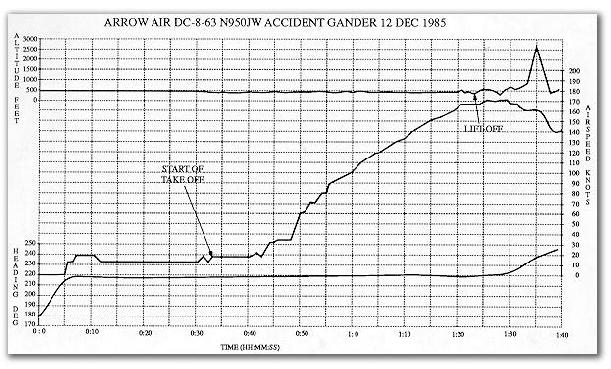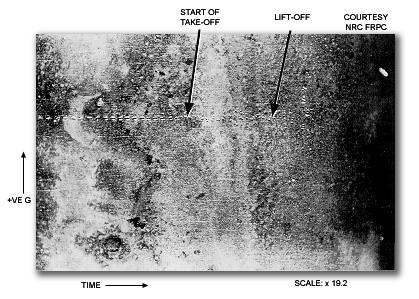|
 |
TABLE OF CONTENTS
(title page)
FACTUAL INFORMATION
ANALYSIS
CONCLUSIONS
SAFETY ACTION
APPENDICES
 |
|
|
| CASB Majority Report |
 |
Cockpit Voice Recorder Playback | Flight Data Recorder Readout
Flight Recorders
The aircraft was equipped with a Sundstrand AV-557A cockpit voice recorder (CVR) and a United Control FA542 flight data recorder (FDR).
The CVR retains the last 30 minutes of four channels of information, recording them on an eight track reversing one-quarter-inch tape made of Vicalloy that travels at a speed of two and threequarter inches per second.
The FDR scribes measurements of pressure altitude, indicated airspeed, magnetic heading, and vertical acceleration on a 4.9-inch-wide stainless steel foil moving at 0.1 inch per minute. The scribe marks are discrete samples made at one-second intervals, except for the vertical acceleration which is normally recorded 10 times per second. Other continuously marking styli) record one-minute time intervals, times of all radio transmissions, and whether the recorded heading is in the northerly or southerly sector of the compass. The foil length of 200 feet provides for 400 hours of recording on one side of the foil. The unit was last calibrated on 11 November 1982.
Both recorders were recovered from the accident site on the afternoon of the accident and were immediately flown to the Flight Recorder Playback Centre (FRPC) of the National Research Council for readout and analysis.
Cockpit Voice Recorder Playback
When the CVR was opened, it was found that the Vicalloy tape was broken in two places close to the tape reels with the piece of tape between the two breaks still in position around the capstans and the tape heads. Tape breakage of the type observed has been found in other accidents and is attributed to impact forces. Apart from the breaks, the tape was undamaged.
The pilot and co-pilot audio channels on the tape and the service interphone channel were found to be recorded normally. The cockpit area microphone channel, although it contained some level of indeterminate wide-band noise, did not have any of the normal crew conversation or background cockpit noise. Some very faint indecipherable voices were judged to be cross-talk from the pilot's audio channels. Occasional microphonic sounds were similar to those observed when the metal tape was momentarily disturbed close to the recording head. At the time of the accident, a number of brief higher amplitude signals were detected. These were determined to be the result of electrical disturbances associated with aircraft breakup.
Flight Data Recorder Readout
When the foil was examined under the microscope of the coordinate measuring machine, it was found that the altitude, airspeed, and heading stylus marks were of the normal elongated shape, although there was an irregularity in spacing of the discrete marks which was probably caused by imperfections in the torque applied to the take-up spool. This irregularity caused a small jump in foil movement every three to four seconds of a type that is frequently observed on this type of recorder.
The vertical acceleration stylus marks were substandard. Instead of fine marks from the pyramidpointed stylus 10 times per second, there were only three or four overlapping round indentations between every jump in foil motion, suggesting that the indentations were being made only about once every second.
Because of the irregularities in the operation of the FDR, extraction of reliable data proved difficult. The coordinates of the stylus marks were initially read and converted into engineering units using standard calibrations. The initial data plots were then updated upon receipt of the recorder's last bench calibration report. Several attempts were then made to further refine the data. These attempts included a lengthy and time-consuming effort to recover and plot individual points of airspeed, altitude, and magnetic heading, assuming a one-second interval between stylus marks, thus circumventing the time errors due to fluctuations in the foil speed.
In order to provide some comparative data to check the validity of the recorder data, measurements were also made of the previous take-off from Cologne en route to Gander. As a further check of airspeed data and to determine the approach descent profiles, similar measurements were made of the approach and landing at Gander. The accuracy of the airspeed trace was considered to be better than plus or minus five knots.
Prior to the take-off, measurements were also made of the distance along the foil at which a stylus that was in continuous contact with the foil indicated keying of the radio transmitters. This procedure established correlation of the arbitrary elapsed time of the foil data with the GMT recorded on the ATC tape.

Figure 1.4. FDR Information for Accident Flight
The recovered data are illustrated at Figure 1.4. The data plot represents an elapsed time of 1 minute 40 seconds commencing at 1014:33. Measurements were terminated where normal progression of the foil ceased. Subsequent to these points, a large number of stylus marks were evident for each parameter, all at approximately the same distance along the foil. These marks were assumed to have occurred during structural breakup.

Figure 1.5. Photo of FDR Vertical Acceleration Trace
Analysis of the recorded data indicated that the take-off roll commenced at 1015:06. Thereafter, airspeed increased steadily to a peak value of 172 KIAS 53 seconds after commencement of the take-off roll, and then decreased.
Examination of the vertical acceleration trace determined that lift-off occurred about 51 seconds after the commencement of the take-off roll.
Based on integration of the true airspeed with allowance for the reported wind, at 51 seconds after brake release, the aircraft was about 8,000 feet from the starting point of the take-off roll and crossed the end of the runway about 57 seconds after the start of the take-off.
As the maximum recorded airspeed was reached, the altitude measurements started to oscillate in an extreme manner. The fluctuations were too large to represent actual height variations and were therefore assessed to be largely due to static pressure errors associated with stall buffet.
No reliable time sequence of vertical acceleration values suitable for estimating flight path was derived. In addition, actual vertical acceleration could not be calculated because pitch and roll information was not available. It was determined that, within a few seconds of lift-off, the recorded vertical acceleration value reached a peak value of 1.26G (where 1.0G corresponds to level flight condition), decreased to about 0.88G, and subsequently oscillated between values as high as 1.30G and as low as 0.77G. During the last few seconds before impact, the values were almost entirely below the 1.0G level, reaching a minimum value as low as 0.72G.
The aircraft heading began to deviate to the right at about the time the peak airspeed was achieved. The heading continued to deviate to 25 degrees right of the runway heading before the FDR ceased operation.



|
|

